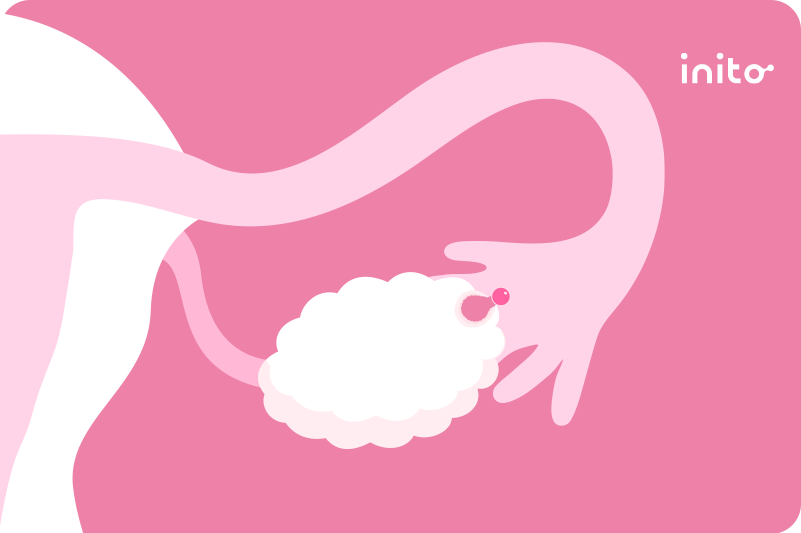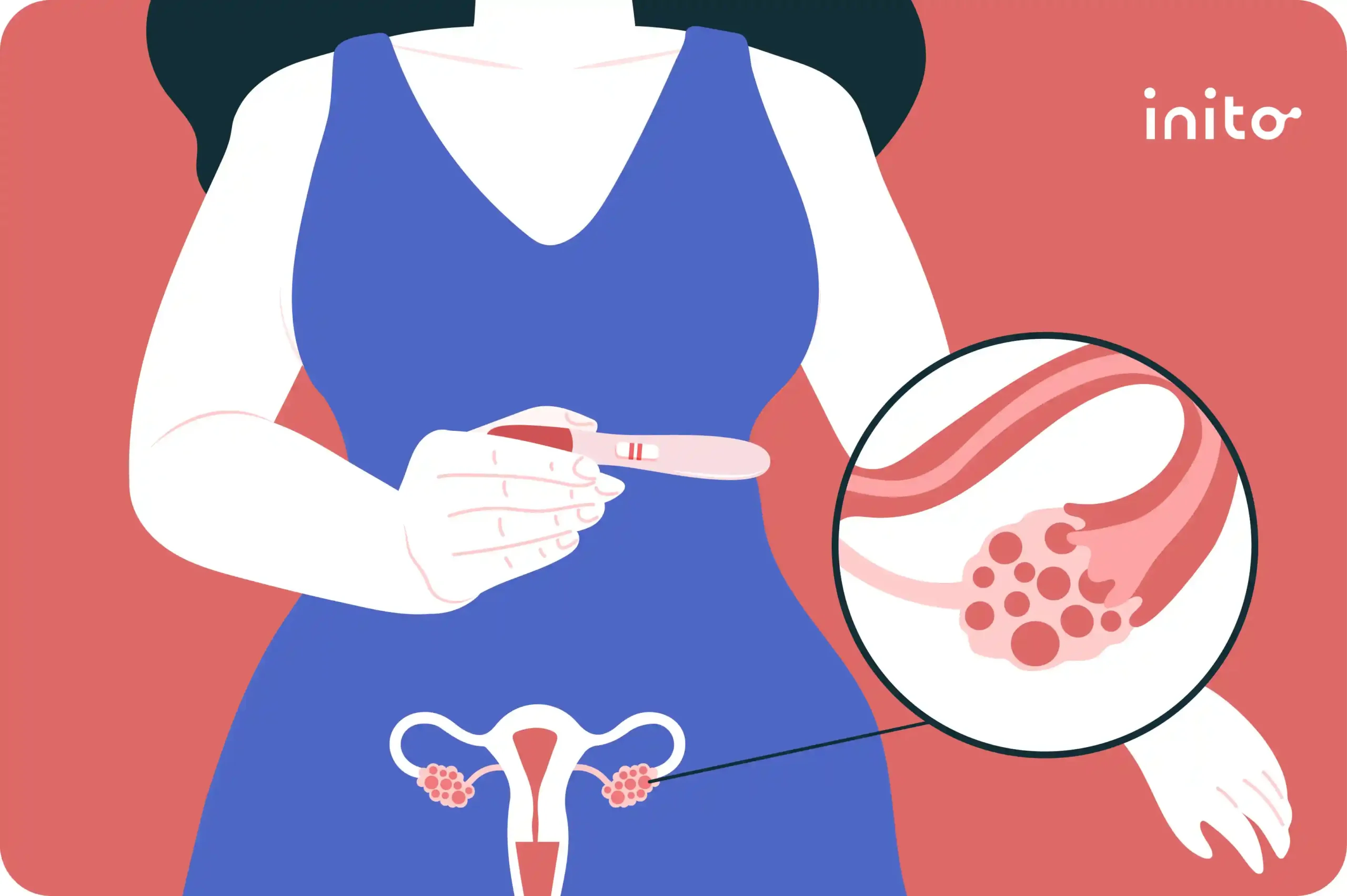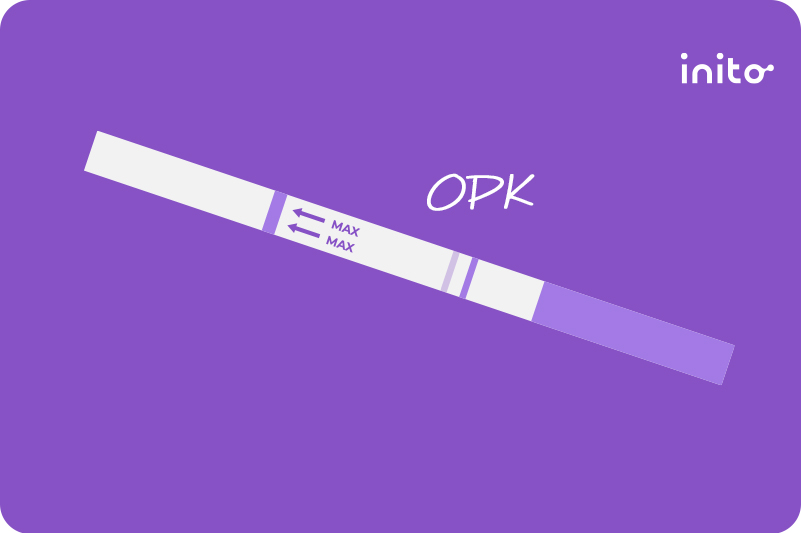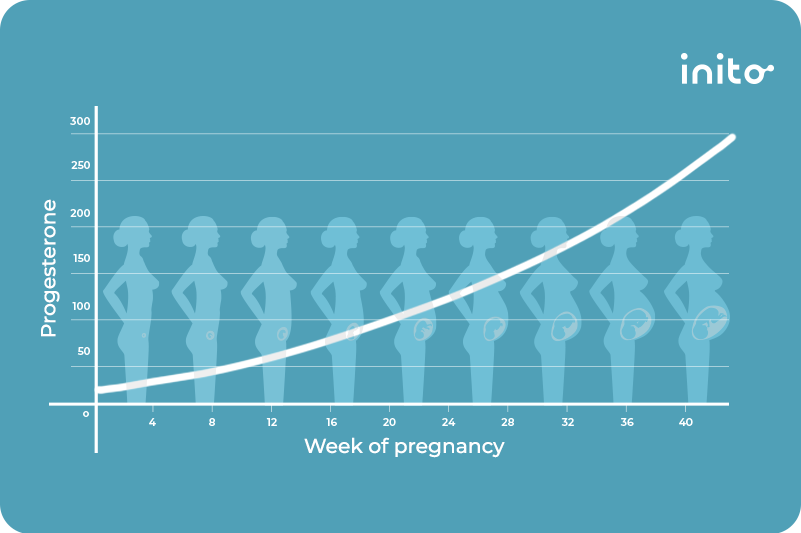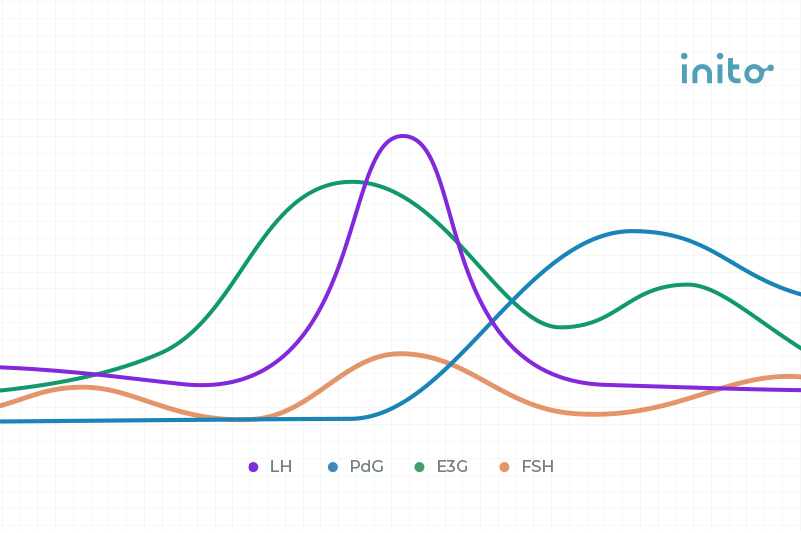Content table
Notice some blood on your underwear mid-cycle? It could be ovulation bleeding.
Ovulation bleeding (or ovulation spotting) happens when an ovary releases an egg. And it’s no cause for alarm.
But let’s be real – any bleeding between periods can make your mind spin.
You may wonder, “Is this normal…what does this mean… and should I be worried?”
We’re here to ease all those fears.
So read on for all the details on ovulation bleeding, including how it looks, how long it lasts, and why it happens.
Takeaways
- Ovulation bleeding is light vaginal bleeding that happens when an egg is released from an ovary.
- It’s usually light pink or red, much lighter than menstrual bleeding, and lasts only a day or two.
- Ovulation bleeding happens around 12-14 days before your next menstrual cycle. Whereas implantation bleeding occurs a few days before your period is due.
- Spotting during ovulation is normal and nothing to be concerned about, but it’s not very common.
- Women who experience bleeding during ovulation tend to have higher levels of progesterone and LH.
- Other signs you’ve ovulated include an increase in BBT, higher libido, more cervical mucus, and changes in cervical position.
What is Ovulation Bleeding?

As the name suggests, ovulation bleeding is light bleeding that happens near the time you ovulate.
Ovulation is that magic moment when an ovary drops an egg into your fallopian tube. The egg remains there for around 12-24 hours. And if you get the timing right – it may be fertilized by a sperm.
Ovulation bleeding (or any spotting for that matter) can stoke a lot of fears. But it’s normal and nothing to worry about.
It’s simply a sign your body released an egg. And if you’re trying to conceive… that’s a good thing!
Although spotting during ovulation is normal, it’s not all that common.
In fact, in one study only 5% of women experience mid-cycle bleeding. And just because you have spotting during ovulation in one cycle doesn’t mean it’ll happen every time.
But if you do have ovulation spotting, it helps to know what to expect.
What Does Ovulation Spotting Look Like?
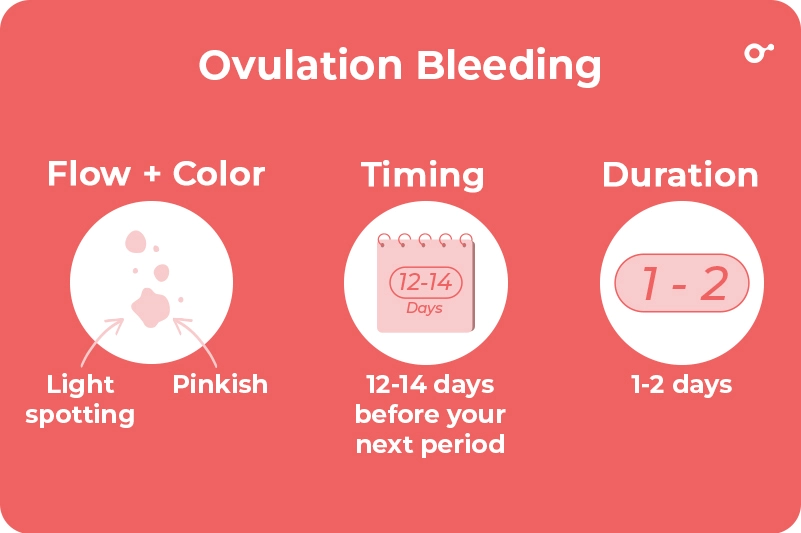
Well, for starters, ovulation bleeding is much lighter than menstrual bleeding. In fact, it may only be a few drops of blood!
The color of ovulation spotting is also different. While menstrual blood is often a bright red, ovulation bleeding is usually light pink or red.
This is because it’s often mixed with cervical fluid, which dilutes the color. Cervical fluid amps up during ovulation to make it easier for the sperm to swim up to the uterus.
But the color of blood can also vary depending on the speed of flow. Blood that’s flowing fast, like on the heavy days of your period, tends to be bright red. But as the flow slows down, it oxidizes and appears darker.
So now that you know what ovulation spotting may look like, let’s cover when it happens.
When Does Ovulation Bleeding Occur?
No surprise here, but it happens when you ovulate. (Go figure)
Ovulation happens around 12-14 days before your next period. So this is the timeframe you may see ovulation bleeding.
For example, if you’re on a 30-day cycle, ovulation spotting may happen around days 16-18 of your menstrual cycle.
Yet, it’s not always that simple.
Ovulation happens at different times for different women. It can even happen at different times for the same woman from cycle to cycle.
So you can’t expect it to happen like clockwork each month. In fact, 46% of cycles vary by seven days, depending on your unique medley of hormones.
This can make it tricky to pinpoint when you ovulate and know when you’re really in your fertile window.
But don’t worry – I’ll share some handy tips for tracking ovulation in a later section. So stay tuned.
How Long Does Ovulation Bleeding Last?
Not long at all. Unlike your period, ovulation spotting only lasts around a day or two.
Now that you know it’s short-lived, let’s clear up why ovulation bleeding happens in the first place.
What Causes Bleeding During Ovulation?
Ovulation spotting is all thanks to the hormonal changes that occur when your body releases an egg. The three main hormones involved are estrogen, luteinizing hormone (LH), and progesterone.
During the first half of your menstrual cycle, estrogen runs the show. But after you ovulate, progesterone becomes the VIP.
Here’s what I mean…
Around 3-4 days before ovulation, estrogen rises. This rise signals your body to amp up the production of luteinizing hormone (LH).
Roughly 24-36 hours before ovulation, LH surges. This triggers your body to release the mature egg and is why ovulation tests use LH to predict ovulation.
After an egg is released, estrogen and LH drop and the empty follicle forms the corpus luteum.
This temporary structure starts cranking out progesterone to support a possible pregnancy.
The shift in the balance from estrogen to progesterone can cause the uterine lining to shed. This may lead to some light bleeding (aka ovulation bleeding).
Why Donesn't Ovulation Bleeding Happen For All Women?
Again, it’s all thanks to your unique hormones. One study found that women with mid-cycle spotting tend to have higher levels of progesterone and LH around ovulation.
But there’s no need to worry if you’re part of the spotting crew. Having higher levels of these hormones doesn’t harm your chances of getting pregnant.
While ovulation spotting is one clue you’re in your fertile window, it’s not the only one.
So let’s cover what other signs of ovulation may let you know it’s baby-making time.
Other Signs of Ovulation to Watch For
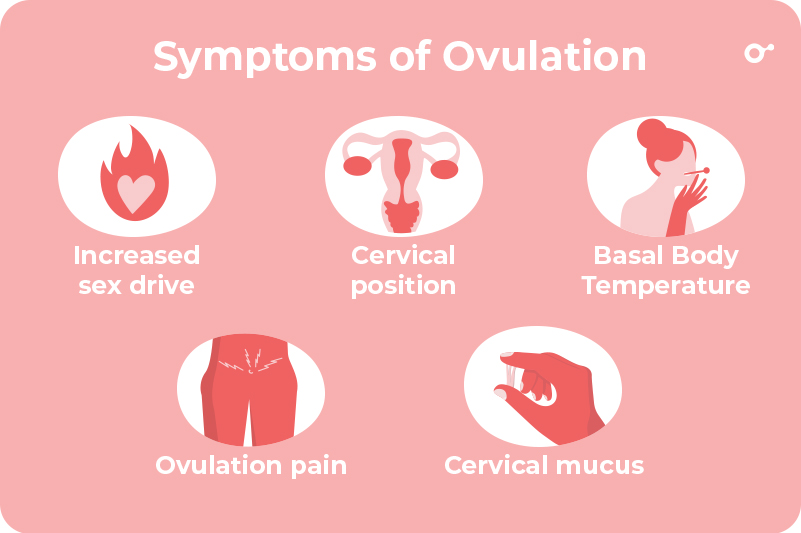
Your body is smart. That’s why before you ovulate, your body goes through certain changes to prepare it for fertilization.
Besides spotting, here are some other ovulation symptoms you may (or may not) notice:
Increased sex drive
You may feel extra frisky in the days before ovulation thanks to your changing hormones. This boost in libido makes it easier for a sperm and egg to meet at the right moment.
Cervical position
Each month during ovulation, your cervix opens up to make the sperm’s journey easier. You can check your cervical position by inserting a finger into your vagina. Check out the video below for a walk-through.
Cervical mucus
Cervical mucus increases when you ovulate. It also becomes stretchy and slippery (similar to egg whites). This makes it easier for sperm to swim in search of an egg.
Ovulation pain
When the empty follicle that holds the egg ruptures, the fluid from the sac collects. This may cause abdominal pain. Ovulation pain, also known as “mittelschmerz,” may feel like a dull ache on one side of your abdomen. Since your ovaries take turns each month, the pain will happen on whichever side releases the egg.
Basal Body Temperature (BBT)
BBT is your temperature when your body is totally at rest. Before you ovulate, BBT is low. But as progesterone rises after ovulation, your BBT increases around 0.5-1.0 degrees F.
If you’re tracking your BBT, it’s best to take it in the morning right after waking up and record it in a notebook.
How do I know it is Ovulation Bleeding vs Implantation Bleeding
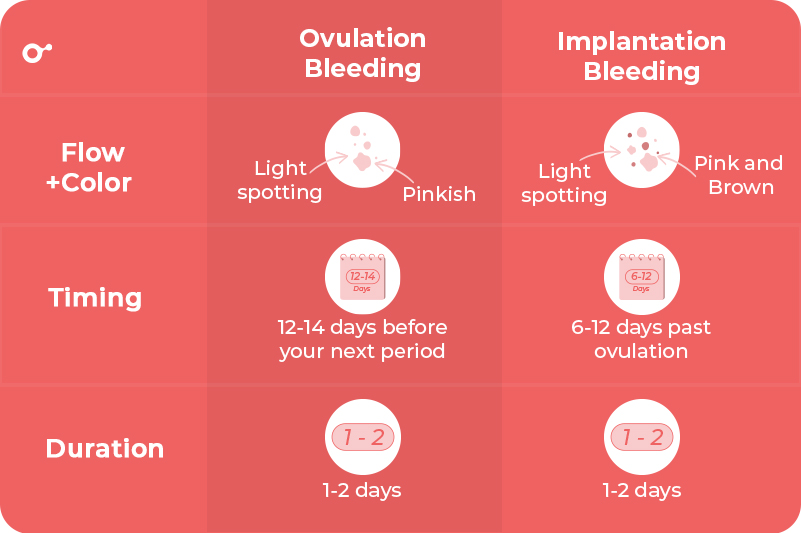
Ovulation bleeding is easily confused with another type of cyclical bleeding: implantation bleeding.
Implantation bleeding happens when a fertilized egg attaches to the uterine wall. When the egg implants, it can cause blood vessels to rupture, leading to spotting.
So how can you tell the difference between ovulation bleeding and implantation bleeding?
It’s all about the timing.
Ovulation spotting happens 12-14 days before your next cycle. But implantation bleeding happens a few days before your expected period.
Implantation usually happens between 8-10 days past ovulation (DPO). But it can occur anywhere between 6 to 12 DPO. This means that you may experience implantation bleeding anywhere from 2 – 8 days before your next period.
While ovulation bleeding isn’t common, around one-third of women experience implantation bleeding. For many, it’s one of the earliest signs of pregnancy.
Implantation Bleeding vs. Period: Breaking it Down
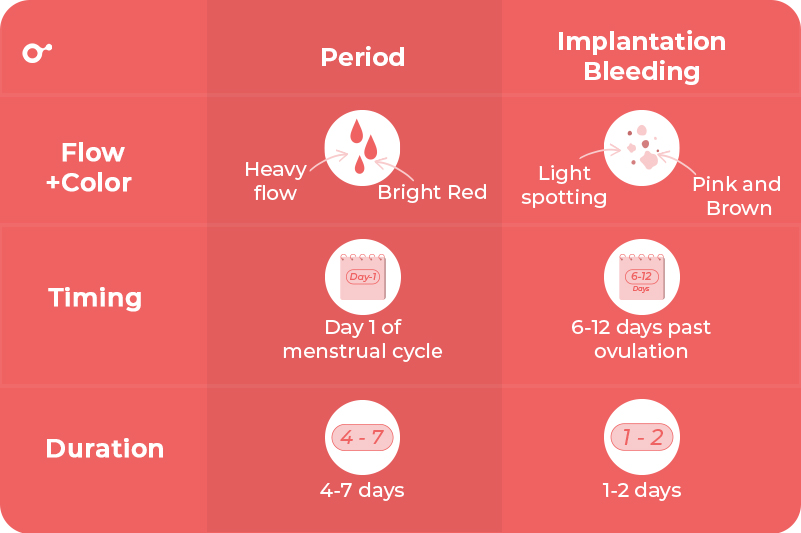
Because of the timing, many women mistake implantation bleeding for their period. But luckily, there are some tricks to help tell them apart.
For starters, implantation bleeding, like ovulation spotting, is much lighter than your menstrual flow and only lasts a day or two. As you very well know, your period lasts much longer, typically between 2-7 days.
The color can also be a giveaway. Period blood is usually bright to dark red, while implantation bleeding is light pink to dark brown. The visual below breaks down the differences between the two.
Learn More: Implantation Bleeding vs. Periods: What Does Implantation Bleeding Look Like?
Other Reasons for Bleeding Between Periods
Other than ovulation and implantation, there are several other reasons for bleeding outside your cycle, including:
- Endometriosis
- Polycystic ovarian syndrome (PCOS)
- Ovarian cysts
- Fibroids or polyps
- Trauma
- Thyroid issues
- Perimenopause
- Ectopic pregnancy
- Sexually transmitted infections (STIs)
Problems with hormonal contraception, including birth control pills, IUDs, and patches
And while rare, some cancers can cause vaginal bleeding, including ovarian, uterine, and cervical cancers.
So how do you know when you’re having some harmless spotting and when it’s something more serious? Let’s clear this up.
When to See a Doctor
Light spotting around ovulation is usually no cause for concern.
But you should talk to your doctor if you experience:
- Excessive bleeding, such as soaking a pad or tampon every 2 hours
- Drastic changes to your usual menstrual bleeding pattern
And you should seek urgent medical attention if you notice:
- Fever or other signs of infection
- Other symptoms such as pelvic pain, dizziness, or lightheadedness
- Severe bleeding that soaks through a pad or tampon within 1 hour
It’s a good idea to keep track of the color and consistency of bleeding, as it can help the doctor make a proper diagnosis.

You know your body best. So if you’re worried about bleeding between periods, give your doctor a call. When it comes to your health, it’s always best to err on the safe side.
Was this article helpful?
- Sonya S. D., et al. (2012). Menstrual Bleeding Patterns Among Regularly Menstruating Women. American Journal of Epidemiology. Volume 175, Issue 6. Pages 536–545.
- Trying to conceive | office on women’s health.
- Clubb E. Natural methods of family planning. J R Soc Health. 1986;106(4):121-126.
- What is implantation bleeding? American Pregnancy Association.
- Long WN. Abnormal vaginal bleeding. In: Walker HK, Hall WD, Hurst JW, eds. Clinical Methods: The History, Physical, and Laboratory Examinations. 3rd ed. Butterworths; 1990.
- What is Implantation Bleeding? ACOG




